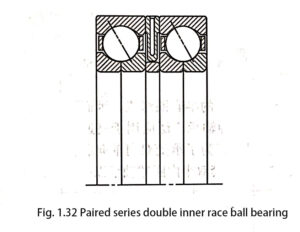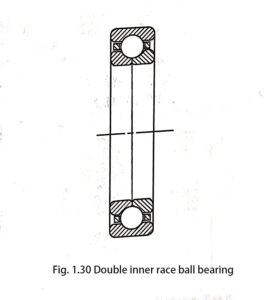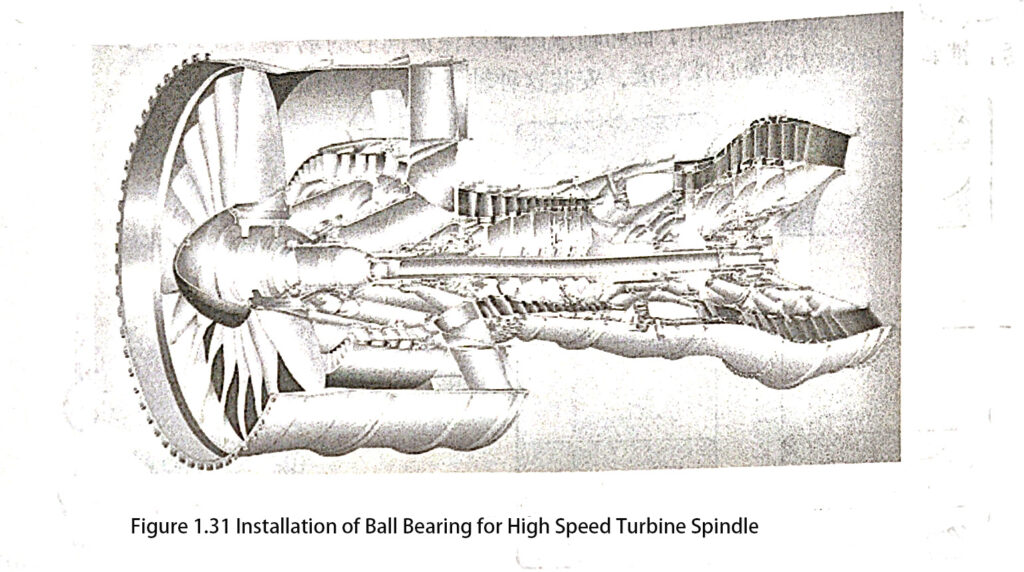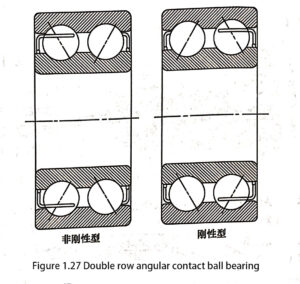1.2.2 Angular contact ball bearing
1.2.2.1 Single row angular contact ball bearing
As shown in Figure 1.23, angular contact ball bearings are designed to withstand combined radial and axial loads or large axial loads. it belongs to ball bearing.The bearing capacity is determined by the size of contact angle. The larger the contact angle is, the greater the axial load can be withstood. Figure 1.24 shows the ball bearing with large and small contact angles. The groove curvature radius of this type of bearing is generally 52%~53% of the steel ball diameter, and the contact angle is generally not greater than 40 °. This type of bearing is generally installed in pairs, and the original clearance is eliminated, as shown in Figure 1.25. The bearing can be pre tightened to improve its axial rigidity. Angular contact ball bearings can also be installed in series to achieve greater axial load capacity, as shown in Figures 1.26
1.2.2.2 Double row angular contact ball bearing
As shown in Figure 1.27, the double row angular contact ball bearing can withstand axial load in any direction or combined radial and axial load. Double row angular contact ball bearing with good rigidity can bear torque load. In essence, the performance of this bearing is similar to that of a pair of double angular contact ball bearings.
1.2.2.3 Double row self-aligning ball bearing
As shown in Figure 1.28, the outer raceway of double row self-aligning ball bearing is part of a spherical surface. Therefore, the bearing has self-aligning function, but cannot bear torque load. Because the coincidence between the ball and the outer raceway is not high (the raceway is not groove), the bearing capacity of the outer raceway is reduced. This deficiency can be more or less compensated by increasing the number of balls to reduce the load borne by each ball. Double row self-aligning ball bearing is applicable to the situation where the shaft and bearing seat are difficult to ensure concentricity. Figure 1.29 shows a double row self-aligning ball bearing with locking sleeve and locknut. When installing this bearing, it is unnecessary to locate the shoulder.
1.2.2.4 Double inner race ball bearing
As shown in Fig. 1.30, the inner ring of the double half inner ring ball bearing is composed of two axially separated half rings, so it can withstand large bidirectional axial load and also suitable radial load. This type of bearing is widely used in high-speed turbine spindles. Figure 1.31 shows the installation drawing of high-speed turbine spindle ball bearing. Obviously, in order to bear the bidirectional axial load, the inner and outer rings of the bearing should be positioned separately on both sides of the bearing. Two sets of double half inner ring ball bearings that have been finely ground in the factory can share the thrust load in a given direction when installed in series, as shown in Figure 1.32.



What’s the difference from deep groove ball bearing? You can get more information here.













